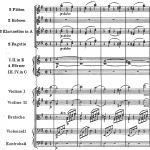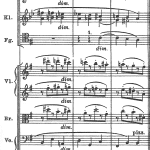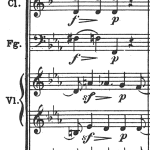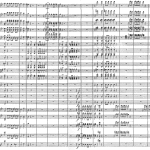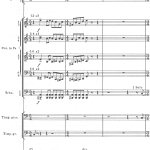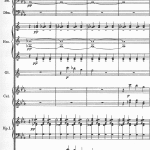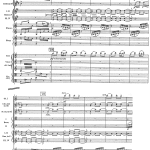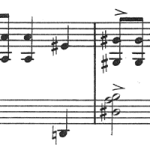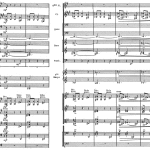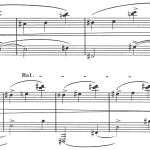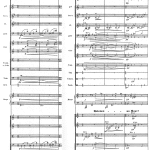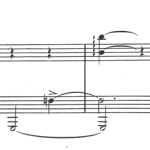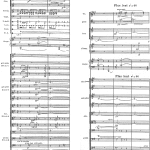With some exceptions (notably heterophony), the various doubling methods described in the previous chapter can all be viewed as intervallic “displacements.” But also temporal displacements such as echo, pre-echo, imitation of acoustic reflection, resonance and reverberation play an important role in writing idiomatically for the orchestra.
Figure 58 · Brahms, Symphony No. 4, 1st movement, m. 1
Figure 59 · Brahms, Symphony No. 4, 4th movement, m. 94
Both of these examples by Brahms show a temporal displacement between woodwinds and strings, like a slightly delayed beat.
The effect of temporal displacement varies with the amount of displacement. Short displacements will typically be perceived as “afterbeat,” reverberation or echo, whereas longer displacements inevitably resemble imitation or canonic techniques. Shorter displacements are frequent in the music of Berlioz, yet another reason to accord him a seminal place in the history of orchestration. The fact that these effects frequently were misinterpreted by his contemporaries as attempts at imitation or canon, gave him the reputation of being a second-rate contrapuntalist, a criticism that was unfounded, since Berlioz’ intention was an entirely different one: rather than counterpoint, the composer aimed at an orchestral imitation of reverberation – the orchestration of acoustic reflection, as it were.
Below a remarkable example of an ultra-short displacement in time. Strings and woodwinds play the same music an octave apart, but the strings are displaced by as little as a single eighth note (quaver). The effect – without a doubt violating the classical rules of harmony – is quite extraordinary[1].
Figure 60 · Berlioz, Symphonie fantastique, 1st movement, m. 44
A special effect that should be mentioned here is the “false” echo, or similar effects reminiscent of the Venetian pian e forte music that originated around 1600. The concept of alternating abruptly between loud and soft (or tutti and solo) and vice versa, has played an important role in the development of music, particularly the concerto form with its so-called “terraced dynamics.” Such effects, often in connection with imitation or repetition, have been further developed in a number of ways in the modern orchestral literature by exploiting abrupt changes in sonority as well as dynamics.
Figure 61 · Berlioz, Harold en Italie, p. 154, m. 3
Figure 62 · Stravinsky, Le sacre du printemps, number 59
Outright echo effects are common as well. See for example figure 16.
In principle, temporal displacement can be combined with any type of intervallic displacement, but the vast majority of temporal displacements occur at the perfect unison or octave, presumably because of their resemblance to echo or reverberation.
A unique form of orchestrated resonance, and by far the most common and frequent even in classical music – is an imitation of the piano’s right pedal, the so-called sustain or forte pedal that lifts the dampers from all strings, sustaining all played notes and adding resonance to the sound of the instrument due to sympathetic vibrations. Just as it is difficult to imagine piano music – except baroque music composed for harpsichord or clavichord – without use of the sustain pedal, orchestral music relies to a large extent on resonance and sostenuto. In both cases, be it piano or orchestra, it is about tying different musical elements together into a smoothly flowing, homogeneous entity. Such imitations of the piano’s right pedal do not occur in baroque music, but the use of basso continuo (usually harpsichord and bass) undoubtedly arose from similar considerations: to provide the music with a sustained and continuous flow.
Traditionally, this binding function involves one group of instruments in particular – the horns. The reasons are many – the horn easily blends with other instruments, and notably has the ability to obscure the location of its own sound source. In a normal playing situation, the bell of the horn is turned not towards the audience, but backwards to the right, and the instrument is known for its lontano effect (i.e. the sound appears to be coming from far away). Long and sustained tones in the horn possess a subdued, almost disembodied character that naturally binds sounds together. A further reason may be the fact that the horn’s natural space lies in the middle register (about an octave on both sides of the piano’s middle C). In fact, many composers and conductors consider the horn group to be the very “heart” of a modern symphony orchestra. A well functioning horn group capable of precise intonation may well deserve a substantial part of the credit when an orchestra produces a harmonious, full-bodied and mellow sound.
The term “pedal tone” is sometimes used to denote low bass notes with a function reminiscent of the piano’s sustain pedal. This, however, is rarely a matter of orchestration, but rather of so-called “pedal points,” a term deriving from the organ.
Use of the horn’s middle register as a kind of “orchestral sustain pedal” can be observed throughout the literature. Below just a few characteristic examples.
Figure 63 · Holst, The Planets, “Venus,” m. 11
Figure 64 · Stravinsky, Petrushka, “Dance Russe,” number 78
As mentioned previously, Maurice Ravel frequently composed music for piano that he would orchestrate at a later point. This applies to his Valses nobles et sentimentales, composed for piano in 1911 and orchestrated the year after. Below a few examples to show Ravel’s use of the horn section, frequently combined with bassoons, transferring the (implicit) sustain pedal of the piano to the orchestra.
Figure 65 · Ravel, Valses nobles et sentimentales I, m. 25
Figure 66 · Ravel, Valses nobles et sentimentales I, number 3, m.
Figure 67 · Ravel, Valses nobles et sentimentales VI, m. 37
Figure 68 · Ravel, Valses nobles et sentimentales VI, number 42
The epilogue of the work uses the hushed pedal resonance of the piano version as the basis for an exceptionally refined and sophisticated animation of the harmonic background. This example once again shows how difficult it can be, if not to say impossible, to establish clear boundaries between instrumentation and composition.
Figure 69 · Ravel, Valses nobles et sentimentales VIII, m. 43
Figure 70 · Ravel, Valses nobles et sentimentales VIII, number71
Although the horn – or the horn section – is clearly the favored instrument or instrumental group when an imitation of the piano’s sustain pedal is called for, other instruments may take part in similar functions. We have already seen that the bassoons may play a comparable role, thanks to their distinct timbral similarities with the horn when playing in the central register of the latter (the two instrument groups sound unusually homogeneous in combination with one another). But also low, unobtrusive tones in the trumpets, as well as the anonymous middle register of the clarinet, are often used[1].
Apart from organ points in the double basses or occasionally cellos, such long “pedal tones” are relatively rare in the upper strings, presumably because sustained notes in a string group have a tendency to become either intrusive or lifeless. Consequently, whenever long, sustained notes are used in the violins or violas, they often appear in the form of tremolos, trills or similar attempts to enliven or animate. Or, if the intention is to create a neutral or less intense background, they can appear as harmonics. The risk of losing intensity may be counteracted by instructing players not to synchronize their bowing. However, coordinated bowing is rooted so deeply in string players, that such an instruction frequently will be met with reluctance or half-heartedness. Mahler, and at times Sibelius (for instance in Tapiola), marks sustained notes in the strings with individual crescendi and diminuendi in different groups in order to preserve the vitality and intensity of the sound.
A particular characteristic of the double basses is their ability to inconspicuously smoothen and integrate the sound when combined with woodwinds or brass alone, as in the opening of Sibelius’ Finlandia below. Such use of the double bass has long traditions – one of the “winds” in Mozart’s famous Gran Partita in Bb major, commonly referred to as his Serenade for 13 Winds, is actually a double bass!
Figure 71 · Sibelius, Finlandia, m. 1
Echo, resonance, reverberation and related effects represent an important and frequently employed aspect of idiomatic orchestral writing, an area that perhaps like no other demonstrates the need to extend our notions of traditional and normative theoretical concepts such as harmony and polyphony, melody and accompaniment or foreground and background. Therefore, the subject cannot be treated exhaustively under a single heading, and will be further discussed in connection with later topics such as Foreground and Background – Melody and Accompaniment, Active Harmony, and Timbre, Sound Combinations and Imitation.
· · ·
Next · Chapter 5. Foreground and Background – Melody and Accompaniment (part 1)
· · ·
[1]Some may find it intriguing that similar minute displacements in time occur in the piano music of Robert Schumann, written at around the same time. Examples of this are his Papillons op. 2, and the “Paganini” movement from Carnaval.
[2]I In some cases, low and discrete pedal tones in the brass, notably the trumpets, are written simply to prevent the instruments from getting cold if not used for a longer period of time. See also Disposition of Form.
